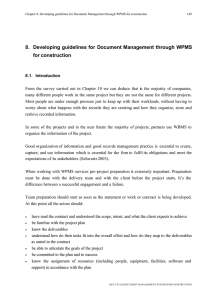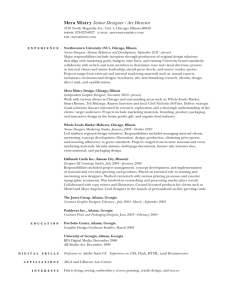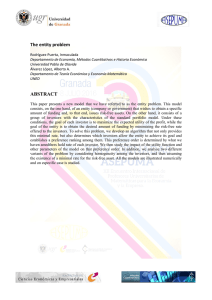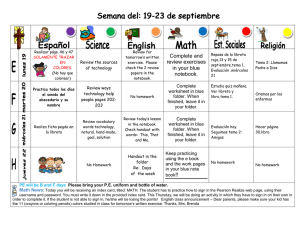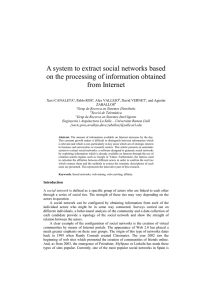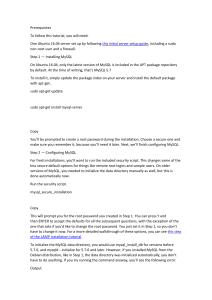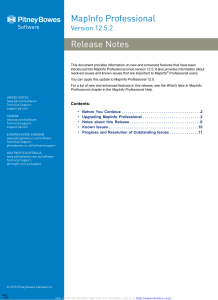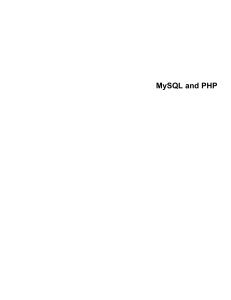9. Developing a Life Cycle Document Management System for
Anuncio
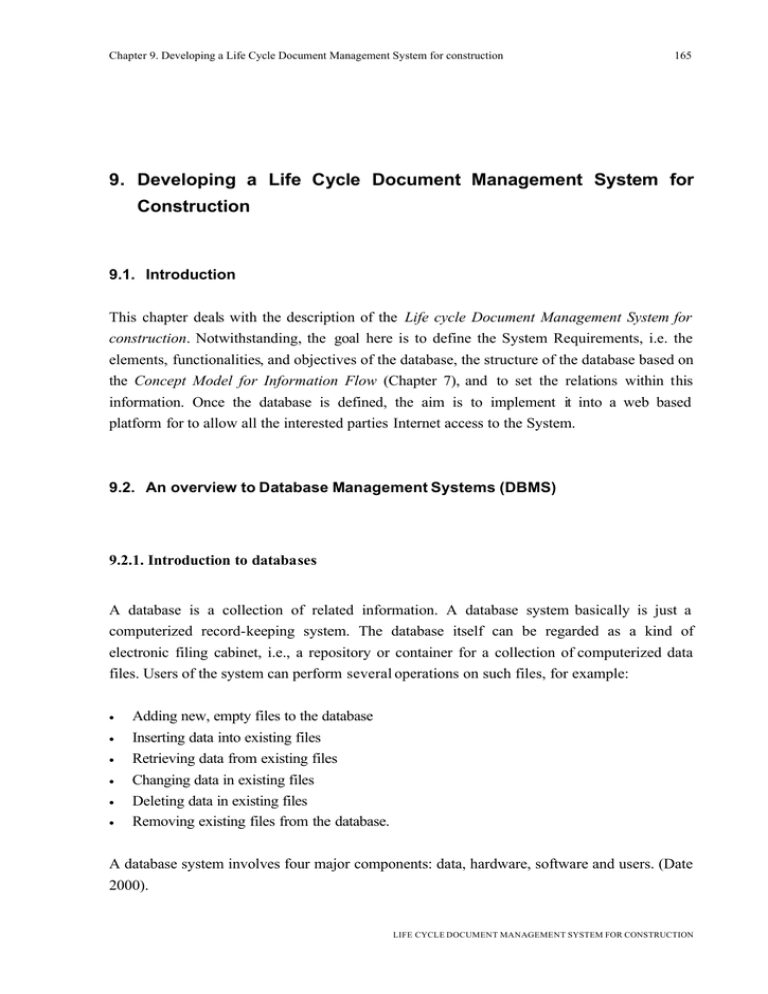
Chapter 9. Developing a Life Cycle Document Management System for construction 165 9. Developing a Life Cycle Document Management System for Construction 9.1. Introduction This chapter deals with the description of the Life cycle Document Management System for construction. Notwithstanding, the goal here is to define the System Requirements, i.e. the elements, functionalities, and objectives of the database, the structure of the database based on the Concept Model for Information Flow (Chapter 7), and to set the relations within this information. Once the database is defined, the aim is to implement it into a web based platform for to allow all the interested parties Internet access to the System. 9.2. An overview to Database Management Systems (DBMS) 9.2.1. Introduction to databases A database is a collection of related information. A database system basically is just a computerized record-keeping system. The database itself can be regarded as a kind of electronic filing cabinet, i.e., a repository or container for a collection of computerized data files. Users of the system can perform several operations on such files, for example: • • • • • • Adding new, empty files to the database Inserting data into existing files Retrieving data from existing files Changing data in existing files Deleting data in existing files Removing existing files from the database. A database system involves four major components: data, hardware, software and users. (Date 2000). LIFE CYCLE DOCUMENT MANAGEMENT SYSTEM FOR CONSTRUCTION 166 Chapter 9. Developing a Life Cycle Document Management System for construction • Data Database systems are available on machines that range from the smallest personal computers to the largest mainframes. The facilities provided by any given system are to some extent determined by the size and power of the underlying machine. In particular, systems on larger machines tend to be multi- users, whereas those on smaller machines tend to be single-user. A single- user system is one in which at most one user can access the database at any given time; a multi-user system is one in which many users can access the database at the same time. In general, data in the database are integr ated and shared. By integration, it’s meant that the database can be thought of as a unification of several otherwise distinct files, any redundancy among those files having been at least partly eliminated. By shared, it’s meant that individual pieces of data in the database can be shared among different users, in the sense that each user can have access to the same piece of data for different purposes. • Hardware The hardware components of the system consist of the secondary storage volumes that are used to hold the stored data, together with the associated I/O devices (disk drives, etc.). The programs themselves can be conventional batch applications, or they can be online applications, whose purpose is to allow an end user to access the database from an online workstation or terminal. Most modern applications belong to the online variety. • Software Between the physical database itself and the users of the system there is a layer of software, known as database manager or database server or, most commonly, database management system (DBMS). Every request for access to the database is handled by the DBMS, the most important software component in the overall system. • Users There are three broad classes of users: First, there are the application programmers, responsible for writing database application programs in some programming language such as COBOL, C++, and Java. Such programs access the database by issuing the appropriate request –typically, an SQL statement- to the DBMS. The programs themselves can be conventional batch applications, or they can be online applications, whose purpose is to allow an end user to access the database from an online workstation or terminal. The second class is the end users, who interact with the system from online workstatio ns or terminals. An end user can access the database via one of the aforementioned online applications, or can use an interface provided as an integral part of the database system LIFE CYCLE DOCUMENT MANAGEMENT SYSTEM FOR CONSTRUCTION Chapter 9. Developing a Life Cycle Document Management System for construction 167 software. Such vendor-provided interfaces are also supported by means of online applications, but those applications are built- in, not user-written. Most database systems include at least one such built- in application, namely a query language processor, by which the user can interactively issue database requests such as SELECT and INSERT to the DBMS. SQL language is a typical example of a database query language. The third class of user is the database administrator (DBA). A DBA directs or performs all the activities related to maintaining a successful database environment. Responsibilities include designing, implementing, and maintaining the database system; establishing policies and procedures pertaining to the management, security, maintenance, and use of the database management system; and training employees in database management and use. 9.2.2. Relational DBMS DBMS organize and structure data so as to be used and manipulated by users and application programmes. DMBS data structure and access technique is called Data Model. The DM of a DBMS defines its ‘personality’. (Groff & Weinberg 1990). When designing a data base the first stage is to choose the adequate Data Model, depending on the tasks to be executed by the database. Database Systems (DS) can be conveniently categorized according to the data structures and operators they present to the user. According to this scheme, the oldest systems fall into three broad categories: relational, hierarchic, and network. In a relational system the user views the data as tables, and views nothing but tables. By contrast, in a non-relational system the user views other data structures, either instead of, or in addition to, the tables of a relational system. Those other structures, in turn, require another operator to manipulate them. For example, in a hierarchic system the data is represented to the user in the form of a set of tree structures (hierarchies). In a hierarchical system there are relations for each data which is stored in individual registers. Therefore, when consulting, registers should be searched one by one, and when there is a great deal of data and relations between them this system becomes slow and inefficient. We do not discuss these categories in detail because, at least from a technological point of view, they must be regarded as obsolete. However, a schema of data organization is presented in order to show the differences. LIFE CYCLE DOCUMENT MANAGEMENT SYSTEM FOR CONSTRUCTION 168 Chapter 9. Developing a Life Cycle Document Management System for construction Phase 1 Stage 1.1 Stage 1.2 Activity 1 Activity 2 Stage 1.3 Activity 3 Figure 25. Example of a hierarchical structure table PHASE Name phase: Description: table STAGE Name stage: Description: table ACTIVITY Name activity: Description: Figure 26. Example of relational organization of tables The first relational products appeared in the late 1970s and early 1980s. Currently, most database systems are relational and run on just about every kind of hardware and software platform available. Advances in database technology and processing offer opportunities for using information in a flexible and efficient way when data is organized and stored in relational structures. A relational data model defines what the data is rather than how it is used, because data is used in multiple applications to serve multiple functions. 9.2.3. Steps to develop a DBMS The overall approach to the semantic modeling problem can be characterized in terms of the following four steps: • First, we attempt to identify the necessities and requirements of the database. • Then, we should identify a set of semantic concepts that seem to be useful in talking informally about the real world. It is called Conceptual Design and aims to obtain a structure of the information of the future DB. In this step the terms : entities, attributes and relations, are used. Entities are objects belonging to the real world that can be distinguished from the rest of objects. These entities can usefully be classified into entity types. The advantage of LIFE CYCLE DOCUMENT MANAGEMENT SYSTEM FOR CONSTRUCTION Chapter 9. Developing a Life Cycle Document Management System for construction 169 such classification is that all the entities of a given type will have certain properties or attributes in common. Every entity has a special an identifier property, i.e., every entity has an identity. Any entity can be related to other entities by means of relationships . • Next, we should devise a set of corresponding symbolic objects that can be used to represent the foregoing semantic concepts. • Then, we should devise a set of formal, general integrity rules, to go along with those formal objects. • Finally, we should develop a set of formal operators for manipulating those formal objects. The best-known semantic modeling approach and the most widely used is the entity/relationship (E/R) approach, based on the E/R model introduced by Chen in 1976. The E/R model introduces the concept of E/R diagram, which constitutes a technique for representing the logical structure of a database in a pictorial manner. The E/R diagramming technique is explained below: • Entity: Each entity type is shown as a rectangle containing the name of the entity type in question. Each entity must have a candidate key to identify it which is called primary key. Elements are the discrete pieces of data which describe and define entities. An attribute is an intrinsic characteristic of an entity. Elements define the attributes of entities. • Properties: Properties are shown as ellipses containing the name of the property in question and are attached to the relevant entity or relationship by means of a solid line. The ellipse border is dotted or dashed if the property is derived, and doubled if it is multi-valued. If the property is composite, its component properties are shown as further ellipses, connected to the ellipse for the composite property in question by means of further solid lines. Key properties are underlined. The value sets corresponding to properties are not shown. • Relationships: Each relationship type is shown as a diamond containing the name of the relationship type in question. The diamond border is doubled if the relationship in question is between a weak entity type and the entity type on which its existence depends. The participants in each relationship are connected into the relevant relationship by means of solid lines; each such line is labelled ‘1’ or ‘M’ to indicate whether the relationship is one-to-one, many-to-one, etc. The line is doubled if the participation is total. In the one-to-one relationship only one element of the first entity can have a relation to only one element of the second entity. In the many-to-one relationship there are many different elements of the first entity that have some kind of relationship to only one element of the second entity. LIFE CYCLE DOCUMENT MANAGEMENT SYSTEM FOR CONSTRUCTION 170 Chapter 9. Developing a Life Cycle Document Management System for construction Afterwards, when defining the symbolic objects, all the elements of the conceptual concept turn into tables. To define correctly a relation database it should obey a group of fundamental premises so we should devise a set of corresponding symbolic objects. It’s important to define accurately all the elements, tables, primary keys, foreign keys and relations of all the stored data. A table is a grouping of related data organized in fields (columns) and records (rows) on a datasheet. By using a common field in two tables the data can be combined. Many tables can be stored in a single database. A table is the ground for organizing a relational database, a bidimensional disposition of rows and columns of the data. Each entity will be represented as a table. Each table of a relational database should have a unique name that identifies its content. Each row represents a unique entity. Each column represents a set of data from the same type. To identify an entity we should create the primary key, which is an attribute of the entity and describes the uniqueness of each entity. A field is a column on a datasheet and defines a data type for a set of values in a table. When creating the relationship between tables, a field from one table is related to another field of another table; the data that is linked between two tables is called foreign key. Each field should contain only one value (atomicity) and all the fields should depend only from the primary key. A record in a row on a datasheet is a set of values defined by fields. Every record in a table must have a primary key that differentiates it from every other record in the table. In some cases it is only necessary to designate an existing field as the primary key, if you are certain that every record in the table will have a different value for that particular field. To prevent the duplication of information in a database by repeating fields in more than one table, table relationships can be established to link fields of tables together. LIFE CYCLE DOCUMENT MANAGEMENT SYSTEM FOR CONSTRUCTION Chapter 9. Developing a Life Cycle Document Management System for construction 171 9.3. Definition of the System Requirements From the Conceptual Model for Information Flow described in Chapter 7, the elements and functionalities of the Life cycle Document Management System for Construction are defined. From Chapter 7 the following conclusions were obtained: • The project document organization should be organized by its life cycle, which is divided into phases / stages. • The type of information, and the area of the project where a piece of information belongs, should also be considered and is stated as activities / subactivities. • The actors that take part in a construction project should be also defined. • From each document, other information (metadata) to track, find, manage and use these data is also relevant. These metadata is divided basically into: Document Name, Description, Late submittal Date, Attribute and Type of document. • Once the document is located and its main characteristics are defined, the relations of each actor with the document -which are described as ‘responsibilities’- should be also taken into consideration. Actually, although there are a vast number of participants in a construction project they have been summarized into three: Client, Designer and Constructor, and are called actors. Each actor can have a different responsibility concerning the document; responsibilities can be: create and receive. This characteristic defines the responsibility for uploading a document in the EDMS and/or for delivering it. The actor responsible for the creation of a document must be aware of who will need the document and when. • Moreover, there are different types of procurement arrangements in a construction project. So, depending on the contractual arrangements, different participants take part assuming different responsibilities: In the Traditional Procurement arrangement the client has a direct contractual relationship with most participants. In the Turnkey Project arrangement, the client delegates all the design and construction responsibilities to external consultants. In Professional Construction Management arrangement there is no main contractor interposed between the owner and the various specialist subcontractors. The construction manager becomes the principal consultant coordinating the entire procurement process. LIFE CYCLE DOCUMENT MANAGEMENT SYSTEM FOR CONSTRUCTION 172 Chapter 9. Developing a Life Cycle Document Management System for construction Once the actors’ responsibilities are defined, these actors should be split into the roles they are going to develop in the project. I.e., depending on the contractual arrangement, the client can perform different roles such as that of a construction manager, which can also be carried out by the designer or the constructor in another type of contractual arrangement. On the whole, the scope of this system is to: 1. Create a folder structure for whatever construction project, to be used in the corporate server, in the individual PCs or in the Web Based Project Management System. The aim is to have the same folder and file structure for whatever actor working in WPMS. This tool aims to improve the internal document management of the company and the interaction between each company (agent) and the WPMS. By choosing some inputs such as the type of contract and the actors that are going to partake in the project, the system generates a matrix where to place each document along the life cycle. To make it easier and in a more traditional way, this organization of information will be downloaded into the user’s PC and it automatically creates the structure of archives, folders, subfolders and so on. This structure will also be downloaded or incorporated into whatever Web based Project Management System. The main objective is to create the same folder structure in each user’s PC and in the Web based Project Management System. 2. Consult whatever information related to the life cycle of the project, document, etc. Users are able to define some inputs such as responsibility for the document (create, receive), project phase (inception, design, etc.), stage (general design, detailed design, etc.), activity (costs, risks, quality, etc.), subactivity (communication, documentation, etc.) and type of document (letter, drawing, etc.). Then the system returns the document organization for these inputs. For example, a designer might want to know when must he/she deliver the specifications of the project; he /she filters, then, the data by type of project - in this case: specifications- and by the responsibility for the project - in this case: create-, and the system tells him/her in which stage of the life cycle, activity and subactivity to deliver the specifications. Another example might be the case of a client wanting to know which documents will he/she receive concerning a specific activity, e.g. costs. The systems returns all the Stages where the client will receive anything related to costs. LIFE CYCLE DOCUMENT MANAGEMENT SYSTEM FOR CONSTRUCTION Chapter 9. Developing a Life Cycle Document Management System for construction 173 9.4. Database Design Criteria Defining the process life cycle as Phases / Stages doesn’t mean that for starting a phase the previous one should be finished. It only gives a temporal character. The same happens with the Stages. It is possible to have overlapping between Phases or Stages. All the information to be represented in this database is like an index. If we represent it as a tree diagram we obtain the following organization of information: Phase 1 Stage 1.1 Activity 1 Figure 27. Tree diagram of a possible alternative Then, the relationships between entities would be 1:N, which means that from the element of the first entity exists N relations that derive from the first one to N registers. This structure can be translated to the following index. 1 Phase 1 1.1 Stage 1 1.1.1 Activity 1 1.1.1.1 Subactivity 1 1.1.1.1.1 Document 1 A relational database works with bidimensional tables but this information can be represented as a matricial structure. Actually, activities and subactivities are repeated in each phase and stage, and the same happens with documents. We can have the document ‘Minutes’ in different stages like in ‘Conceptual Definition’ or in ‘Construction’, and these documents can be stored in different activities like ‘Contractings’ and ‘Quality’, and in different subactivities such as ‘Communication’ and ‘Organization’. This doesn’t mean that there are redundancies of activities in different phases, but only that the entities names such as activity, subactivity, and documents, are repeated in different Phases and Stages but not their contents. LIFE CYCLE DOCUMENT MANAGEMENT SYSTEM FOR CONSTRUCTION 174 Chapter 9. Developing a Life Cycle Document Management System for construction Table 17. Examples of repetition of different elements from different tables Phases Execution Conception Stage Construction Conceptual definition Activity Quality Contractings Subactivity Organization Communication Document Minutes Minutes Phases Execution Stage Construction delivery Activity Costs Subactivity Documentation Document Letters Execution Construction delivery Costs Communication Turnover Consequently, the relation between Phases / Stages and Activities / Subactivities adopts the following form: Activity Phase N N M M Subactivity Stage N N M M DOCUMENT Figure 28. E/R diagram to organize documents along the life cycle Once the document is defined and placed in the life cycle of the construction Project, we should analyze the responsibilities each participant has in relation to the document. As stated in Chapter 7, although there are many participants in a construction project we have reduced them into three: Client, Designer and Constructor, and are called actors. Each actor can have a different responsibility for the document, so we have divided the responsibilities into two: create and receive. Another condition of the responsibility of each actor is the contractual arrangement of the project. Depending on the contract, each actor will partake in the project assuming different responsibilities. This relation between Contracts, Agents, and Documents, is summarized in the following entity/relationship diagram: Creates/receives DOCUMENT N N Actor N Contract Figure 29. E/R diagram between Documents, Contracts, and Agents LIFE CYCLE DOCUMENT MANAGEMENT SYSTEM FOR CONSTRUCTION Chapter 9. Developing a Life Cycle Document Management System for construction 175 From each document we also want to know which document and type of documents does it relate to. Table 18. Examples of related documents Phases Conception Execution Stage Feasibility Study Construction Activity Project Advance Subactivity Documentation Monitoring and Control Document Annex Defects list Depends of Memory Non conformities The entity / relationship diagram to show these relations is the following: N DOCUMENT Depends of M M N Atribute Figure 30. E/R for the attribute of documents and relations between documents If we join all this entities and relations together we obtain the E/R’s diagram of the whole database. The database consists of 9 tables. Each one stores information about a particular type of entity (we have split the information in tables for a better functioning of the database, for to improve the actualization of data and the celerity of the consultations). All the information relating to a generic project is stored in a database. There are several tables in the database design, as shown in Figure 32. One of these tables is called ‘Relation’ and enables the different information from each table to be matched up. The fact that the same actor can assume different roles in different projects compels us to define all the potential actors/roles related to a document. In general terms, the information is divided into the following tables: • PHASE and STAGE, where the previously defined different phases and stages along the project life cycle are stored. • ACTIVITY and SUBACTIVITY, where the various project areas are stored. • AGENT, that stores the three main agents of a project: Client, Designer and Contractor. LIFE CYCLE DOCUMENT MANAGEMENT SYSTEM FOR CONSTRUCTION 176 Chapter 9. Developing a Life Cycle Document Management System for construction • ROLE, that stores information about the role each project agent can perform. It’s important to notice that one agent can carry out many different roles, and one role can be played by different agents. • DOCUMENT, that contains all the metadata explained above, such as document name, description, late submission date, revision number, and type of stored information. • ATRIBUTE is an auxiliary table that gives extra information about the document, such as the format of the document. • RELATION, that contains the organization of documents in to Phases / Stages /Activities / Subactivities / Documents, and tells who creates and receives these documents and which documents are concerned. • CONTRACT assigns each actor a task related to a document. It consists of a type of contract and their characteristics. It is used to select the responsibilities of an agent/role for a document. • CREATE-RECEIVE contains the responsibilities of each agent depending on the contract, the type of document and the place of this document in the life cycle of the project. Following the E/R diagram called Chen’s diagram is exposed. Activity Phase N N M M Subactivity Stage N N N M DOCUMENT Depends of Creates/receives M M N N M N N Contract Atribute Figure 31. E/R diagram of the proposed database LIFE CYCLE DOCUMENT MANAGEMENT SYSTEM FOR CONSTRUCTION Actor Chapter 9. Developing a Life Cycle Document Management System for construction 177 Phase name phase Stage name stage Activity name activity Subactivity name subactivity Type type name extension Contract type of contract characteristics Actor name actor Role type of role company address contact person Document doc name project revision nº description Figure 32. Contents of different tables Figure 33 shows the shows the proposed conceptual schema of the system, broken down into three different dimensions: Presentation, Product and Life cycle dimension. Contract defines Project documentation is a is a Documents set is part of is subjected to Atribute is part of Lifecycle Stage Lifecycle Phase depends on has DOCUMENT Relation is Digital has is subjected to is subjected to Activity is Subactivity Type has responsibilities on Name Actor Description Late submittal date PRESENTATION DIMENSION LIFECYCLE DIMENSION PRODUCT DIMENSION Figure 33. Conceptual schema of the System LIFE CYCLE DOCUMENT MANAGEMENT SYSTEM FOR CONSTRUCTION 178 Chapter 9. Developing a Life Cycle Document Management System for construction 9.4.1. Contents of each table phase Id phase phase fase can Conception Concepción dn ec Desactivation Execution Desactivación Ejecución cc Purchase and contractings Compras y contrataciones dt Technical Design Diseño Técnico stage Id stage apr stage Conceptual Definition etapa Definición conceptual con Construction Construcción cde cnt Construction Delivery Contractings Entrega Compras y Contrataciones dpr sbr Detailed Proposal Feasibility Study Propuesta detallada Estudio de viabilidad fpr Final Proposal Propuesta final mai opr Maintenance Outline Proposal Mantenimiento Propuesta inicial pcc pot Production of information for contractings Production of information for tender Producción de información para contratación Producción de información para licitación tac Tender action Concurso o licitación tdo Tender documentation Documentación para concurso o licitación activity Id activity activity actividad adv chn Advance Changes Avance Cambios cnt cst Contractings Costs Contrataciones Costes env Environment Medio Ambiente prg prj Programming Project Programación Proyecto qlt rsg Quality Risks Calidad Riesgos sah Safety and Health Seguridad y Salud subactivity Id subactivity subactivity subactividad com doc Comunication Documentation Comunicación Documentación log Logistics Logística mac cdn Monitoring and Control Organization Seguimiento y Control Organización pln pur Plan Purchasing Plan Compras, Suministros std Studies Estudios LIFE CYCLE DOCUMENT MANAGEMENT SYSTEM FOR CONSTRUCTION Chapter 9. Developing a Life Cycle Document Management System for construction 179 document Id document tad document Administrative procedure documento Trámite administrativo ann rps Annexe Answer Anejo Respuesta afd dac Approval Awarding Aprobación Adjudicación pre Budget Presupuesto oes cit Bylaws Catalogue Ordenanzas, Normativas y Reglamentos Catálogo crt cmb Certification Change order Certificación Orden de cambio idc Communication report Informe de Comunicación cnt pcc Contract Control Plan Contrato Plan de Control ldd pls Defects List Drawing Lista de defectos Plano fmt Form Formato dgc inc Generic document Incidence Documento genérico Incidencia sif pdi Information request Inspection Points Solicitudes de información Puntos de inspección int Instruction Instrucción seg alb Insurance Delivery note Seguro Albarán inv Invoice Factura cts lcp Letter Licence Carta Licencia-permiso man med Manual Measurements Manual Mediciones reu Meeting Reunión mem act Memory Minute Memoria Acta ncf org Non-conformities Organization chart Inconformidades Organigrama pgs Payments Pagos plf prc Planning Procedure Planificación Procedimiento prg rec Programming Receipt Programación Recibo ins Report Informe pdo ldo Request of tender Site Book Petición de ofertas Libro de obra snt spc Site Note Specifications Nota de obra Especificaciones orb Tenders Ofertas fct tcl Turnover Visa procedure Facturación Trámite colegial LIFE CYCLE DOCUMENT MANAGEMENT SYSTEM FOR CONSTRUCTION 180 Chapter 9. Developing a Life Cycle Document Management System for construction agent Id agent agent agente i Client Cliente o Contractor Contratista d Designer Diseñador pc contract contract professional construction management arrangement contrato contrato dirección integrada tr traditional procurement arrangement contrato tradicional tk turnkey project arrangement contrato llaves en mano Id contract 9.5. Implementation of the database to a web based system 9.5.1. Possible solutions Microsoft Office is the most popular and the easiest software for any particular or SME that cannot invest on tools with major possibilities neither has enough knowledge about more complicated tools. On the other hand, Internet evolution has lead to new technologies. The contents first were totally static but in a short period since the arrival of scripting languages, the World Wide Web together with HTML language has reached to dynamic pages. In these dynamic pages the user cannot only read, search and browse information, but also interact with this information and send it via forums, forms, quests, comments, etc.; the page administrator can give permissions to users, so avoiding constant modifications of the page base code. According to Trigos (2000), 90% of Internet websites implement a database system to actualize, modify, eliminate and incorporate information. DMS or WPMS are based on these dynamic pages. PHP is one of the languages broadly used by programmers due to its vast advantages, like being Open Source, and to its broad functioning platforms: Windows, Unix, Solaris, etc. Some databases that can work with PHP are SQL Server, MySQL, etc. MySQL (My Structured Query Language) is a Relational Database Management. As aforementioned, a database is a structured collection of data, and a relational database is characterized for having all these information in tables so the relations among data are made explicit in these same LIFE CYCLE DOCUMENT MANAGEMENT SYSTEM FOR CONSTRUCTION Chapter 9. Developing a Life Cycle Document Management System for construction 181 data. This increases speed and flexibility. MySQL is also an Open Source software, fast, robust, and easily usable for large and small projects. It’s obvious that if the model we are proposing is to be used to improve the document organization of those companies working together in a WPMS, it’s necessary to have the database available on Internet. In this case, users don’t need to download any type of software, but just access Internet and choose the specific information such as the type of contract and the type of actor. The results will be automatically viewed locally (in the user’s PC) or in the WPMS. We have developed the database in MySQL using PHP to upload the database via Internet, but also in Access, in case Internet access is not possible and users only want to use this database locally. 9.5.1.1. My SQL MySQL database server is the world's most popular open source database. MySQL has quickly become the core of many high- volume, business-critical applications. Customers such as Yahoo, Google, Cisco, Sabre Holdings HP and NASA, are realizing significant cost savings by using MySQL's high performance, reliable database management software to power large Web sites, business-critical enterprise applications and packaged software applications. MySQL offers several key advantages: • Ease of Use and Deployment. MySQL's architecture makes it extremely fast and easy to customize. Its multi-storage engine architecture gives customers the flexibility they need with a DBS such as speed, compactness, stability and ease of deployment. • Open source. This refers to a Free Software-related kind of software licensing and distribution. The consumer of an open source program is entitled to: read, use, modify and distribute the source; charge money for services, copying or support, so long as they do not hinder others’ freedom. Open source isn't PublicDomain. It means that there is a license involved, and the license has restrictions which can include: distribution must be free; modifications must be distributed; original authors must be acknowledged; derivatives must be similarly licensed. LIFE CYCLE DOCUMENT MANAGEMENT SYSTEM FOR CONSTRUCTION 182 Chapter 9. Developing a Life Cycle Document Management System for construction • Cross-Platform Support. MySQL is available on more than twenty different platforms including major Linux distributions, Mac OS X, UNIX and Microsoft Windows. • Millions of Trained and Certified Developers. MySQL is the world's most popular open source database, so it's easy to find high-quality, skilled staff. MySQL has the capabilities to handle most corporate database application requirements with an architecture that is extremely fast and easy to use. 9.5.1.2. PHP PHP, which stands for ‘PHP: Hypertext Preprocessor’, is a widely-used Open Source generalpurpose scripting language that is especially suited for Web development and can be embedded into HTML. Its syntax draws upon C, Java, and Perl, and is easy to learn. The main goal of the language is to allow web developers to write dynamically generated web pages quickly. 9.5.2. Application of the database to a web product The contribution of this thesis is the automatic creation of the organization of folders, subfolders and archives before starting using a WPMS or before starting using an EDMS. This system can be used alone, before starting a project, with the aim to create the same folder structure for all the actors taking part in a project. All the actors should access the system and download the folder structure for the specific project created automatically. It can also be implemented as a function of a WPMS. Once the different actors access the WPMS they can have the functionality of downloading the same folder structure previously created by the web system. This model is designed to be used by any SME or any kind of WPMS. Before starting using a WPMS, the organization of folders, subfolders and archives should be designed. For this reason, this model is independent of the WPMS in use: Foreign companies with ICT services; ICT companies with or without national support that operate in the same country; Construction Companies that have created their own EDMS via extranet. Current WPMS provide the same services such as chat, webcam, document version management, agenda, news, archive management, etc. LIFE CYCLE DOCUMENT MANAGEMENT SYSTEM FOR CONSTRUCTION Chapter 9. Developing a Life Cycle Document Management System for construction 183 When a company considers using a WPMS for a specific project or for all its projects, an actual DMS can be used or the company can create its own. However, none of the existing software in Spain maps all the possible documentation generated throughout the life cycle of the project. So, the system is a web service where to define the characteristics of the project and to obtain the organization structure of documents to be used in each specific project. Then, the application will allow to create a local folder organization of documents or to create it in whatever WPMS. A web based ‘Life cycle Document Management System’ was created to test the database model. It can be accessed online at http://www.constructiondms.upc.es. Figure 34. Access to the Construction Document Management System The previous figure shows the access web page to the System. For the moment, the system is available in English and Spanish but it’s a language independent tool, so it can be easily translated into whatever language. LIFE CYCLE DOCUMENT MANAGEMENT SYSTEM FOR CONSTRUCTION 184 Chapter 9. Developing a Life Cycle Document Management System for construction The User’s guide is available in Appendix II. Notwithstanding, the system is self understandable, in each screen the user will find the purpose of the system and an explanation of what to do in each step. The Administrator should be aware of all the participants and their roles throughout the entire project, and will be in charge of ensuring that the web page functions correctly, and of managing the project. Once the Administrator has introduced his/her username and password, he/she should create a project, define the specific contractual arrangement for this project and assign passwords to the users (actors) of the specific project. As aforementioned, one user can have different roles in different projects, so each role will be chosen and assigned to the user. Figure 35. Assignment of Users and Passwords Figure 35 shows the first screen, where the Administrator creates a project, chooses the type of contractual arrangement and assigns passwords to users. LIFE CYCLE DOCUMENT MANAGEMENT SYSTEM FOR CONSTRUCTION Chapter 9. Developing a Life Cycle Document Management System for construction 185 Once the users have their password they can access the system. The next figure shows the general structure of the system, organized by screens and functionalities. LIFE CYCLE DOCUMENT MANAGEMENT SYSTEM FOR CONSTRUCTION Page 4 download admin Page 1 HOME PAGE User: Password: Page 2 Page 3 Create a project: Define contract: Assing Passwords to users of the project: In a specific Project/Contract Download or consult In a specific Project/Contract Download structure into a WPMS Page 5 consult In a specific Project/Contract Select information to consult Page 6 In a specific Project/Contract View results Make another consult Visualize doc. metadata Page 7 In a specific Project/Contract Visualization of document metadata Page 10 download user Page 8 HOME PAGE User: Password: Page 9 In a specific Project/Contract/Actor Download structure into a PC In a specific Project/Contract Define actor Download or consult Page 11 In a specific Project/Contract/Actor consult Select information to consult Page 12 In a specific Project/Contract/Actor View results Make another consult Visualize doc. metadata Page 13 In a specific Project/Contract/Actor Visualization of document metadata Chapter 9. Developing a Life Cycle Document Management System for construction 187 After accessing the system, the administrator and the actors will have the same possibilities, except for downloading the folder structure in a WPMS, which will only be accessible for the administrator. Once the user has the password for a specific project, he/she should define the type of actor he/she is, i.e. client, contractor and/or designer. For each specific project there is a specific organization of documents related to the contractual arrangement and to the role each user is playing. The user, then, has two options: Download or Consult. Figure 36. Options of the System With the Download option, the user can download into his/her PC the same folder structure, which the administrator has already uploaded into the WPMS. In this case, the system creates a life cycle folder structure with all the documents to be used in the project. LIFE CYCLE DOCUMENT MANAGEMENT SYSTEM FOR CONSTRUCTION 188 Chapter 9. Developing a Life Cycle Document Management System for construction The following figure shows the ‘Download option’. Figure 37. Options to download the folder structure After choosing the option ‘Download in your PC’, if you double click on the archive ‘Carpetas.bak’ the system creates the specific folder and documentation structure for the project. The following screen shows an example of a project FO2004 with its folder structure and the documents of a subfolder. LIFE CYCLE DOCUMENT MANAGEMENT SYSTEM FOR CONSTRUCTION Chapter 9. Developing a Life Cycle Document Management System for construction 189 Figure 38. Creation of the folder structure LIFE CYCLE DOCUMENT MANAGEMENT SYSTEM FOR CONSTRUCTION 190 Chapter 9. Developing a Life Cycle Document Management System for construction Another option is to make consults about specific documents to be uploaded or downloaded in a specific project. The following figure shows the screen used to select information such as: type of document, responsibilities -which means if the actor should create that document and upload it into the WPMS, or if he/she will receive it and use it. The other information is organized in a matrix where the user can choose the phases and stages along the life cycle, the activities and subactivities. Figure 39. Screen for making consults The actor can consult the documentation to be delivered in whatever phase, stage, activity or subactivity. Or he/she can consult the documents that he/she should upload in a specific stage. Or who should deliver the document from a specific activity related to a stage. To do so, actors should only have to click on the gaps of the information they want to filter. After choosing the information to be filtered, the system returns a table like in the following Figure, with the results. LIFE CYCLE DOCUMENT MANAGEMENT SYSTEM FOR CONSTRUCTION Chapter 9. Developing a Life Cycle Document Management System for construction 191 Figure 40. Results of the consult If the user wants more information about a document, he/she should click on it, and the system returns all the information related to that document. An example of that screen is shown in the next figure. LIFE CYCLE DOCUMENT MANAGEMENT SYSTEM FOR CONSTRUCTION 192 Chapter 9. Developing a Life Cycle Document Management System for construction Figure 41. Metadata of a specific document LIFE CYCLE DOCUMENT MANAGEMENT SYSTEM FOR CONSTRUCTION Chapter 9. Developing a Life Cycle Document Management System for construction 193 9.6. Database functioning Although database can be used for many different purposes, the most important function consultation. Consults are basically done through the ‘Relation’ table, but they can also be done through any other table. We can limit the fields to be shown. For example, if we choose the ‘turnkey contract’ and the actor ‘constructor’, we can limit the consult and ask only to give us the ‘Phases’, ‘Stages’ and ‘Activities’ where this actor should create a ‘Minute’. Then we would obtain the following results: Table 19. Results obtained from the proposed database when we select: Turnkey contractual arrangement where the contractor will have to create a Minute. Phases Technical Design Stage Final Proposal Project Activity Subactivity Communication Purchase and contractings Contractings Contractings Communication Execution Execution Construction Construction Advance Changes Organization Organization Execution Execution Construction Construction Changes Contractings Communication Communication Execution Construction Costs Communication Execution Execution Construction Construction Environment Programming Communication Organization Execution Construction Project Communication Execution Execution Construction Construction Quality Risks Organization Communication Execution Execution Construction Construction Delivery Safety and Health Programming Communication Communication Desactivation Maintenance Advance Communication Desactivation Desactivation Maintenance Maintenance Costs Environment Communication Communication Desactivation Desactivation Maintenance Maintenance Programming Project Communication Communication Desactivation Maintenance Quality Communication Desactivation Maintenance Safety and Health Communication Then this table will be translated into: LIFE CYCLE DOCUMENT MANAGEMENT SYSTEM FOR CONSTRUCTION 194 Chapter 9. Developing a Life Cycle Document Management System for construction Technical design Final proposal Project Communication Purchase and contractings Contractings Contractings Communication Execution Construction delivery Programming Communication Construction Advance Organisation Changes Organisation Communication Contractings Communication Costs Communication Environment Communication Programming Organisation Project Communication Quality Organisation Risks Communication Safety and Health Communication Desactivation Maintenance Advance Communication Costs Communication Figure 42. Translation of the results into an organization document file LIFE CYCLE DOCUMENT MANAGEMENT SYSTEM FOR CONSTRUCTION Chapter 9. Developing a Life Cycle Document Management System for construction 195 We can also obtain the results of all the documentation to be created or received by any actor in a ‘typical contractual arrangement’, from defining a specific Stage. Table 20. Results obtained from the proposed database when we ask to obtain all the documentation to be created or received by any actor in a typical contractual arrangement, from defining the Conceptual definition stage and the Advance and Project Activities. Activity Advance Subactivity Monitoring and Control Document Generic documents Create Designer Receive Client Advance Advance Monitoring and Control Communication Reports Minutes Designer Designer Client Client Advance Advance Communication Communication Letters Communication reports Designer Designer Client Client Advance Communication Meetings Designer Client Advance Advance Communication Communication Answers Information requests Client Client Designer Designer Project Project Documentation Documentation annexes Memory Designer Designer Client Client Project Documentation Reports Designer Client Project Project Communication Communication Information requests Minutes Client Designer Designer Client Project Project Communication Communication Letters Communication reports Designer Designer Client Client Project Communication Meetings Designer Client Project Communication Answers Client Designer 9.7. Example A Sports company (CLIENT) decides to build a new Sports Centre in Barcelona. To do so, it contracts ‘an Architect (DESIGNER) to design the building. This architect subcontracts an engineer (DESIGNER) for the specific HVAC and electrical facilities. The Client has a direct relationship with some CONTRACTORS because it’s not the first Sports Centre it opens, so it decides to contract a main contractor who will be responsible for the construction itself, even though the work will be actually undertaken by different specialties subcontractors. When the project starts, the Client firm wants to hold direct relationship with most participants and to control their work. Because of this, it decides to contract a WPMSASP where all the stakeholders of the project should store their information. The client decides to outsource this service because he is not specialist on IT. The main functionalities of these WPMS are Team Communication and Document Management. The company decides to use a WPMS because it is convinced that the communication LIFE CYCLE DOCUMENT MANAGEMENT SYSTEM FOR CONSTRUCTION 196 Chapter 9. Developing a Life Cycle Document Management System for construction between all the stakeholders will improve, reducing costs, but the most important point is the improvement of project control. Before starting using this WPMS, as it doesn’t provide a folder structure where to store all the information, the client decides to use the ‘Life cycle Document Management System for Construction’. With this tool, the administrator, in this case the Client defines the type of contractual arrangement and the users. Type of contractual arrangement: Traditional procurement arrangement User 1: Client User 2: Architect (Designer) User 3: Engineer (Designer) User 4: Main contractor (Contractor) User 5: Electrical Supplier (Contractor) User 6: HVAC installer (Contractor) This System generates the folder, subfolder, documentation, etc., for the Sports Centre project. It defines 3 actors: The Client, the Designer which involves the architect and the engineer, and the Contractor involving the main contractor, electrical supplier and HVAC installer. The administrator downloads into the WPMS the folder structure provided by the ‘Life cycle Document Management System’. Now, when accessing the WPMS, all the partners will view the same folder structure and they will probably know where to store all the information. The administrator also provides passwords to the ‘Life cycle Document Management System’ to all the users. These users will only have access to the folder structure that the administrator has created for the specific project. Then each actor will be able to download this folder structure to their PC, server or Intranet. Now, all the actors of the project will have internally the same folder structure as the WPMS-extranet, and it will be easy to know where to store each piece of information and where to find it if needed. Different parts of the project life cycle will be shown as an example of functioning. LIFE CYCLE DOCUMENT MANAGEMENT SYSTEM FOR CONSTRUCTION Chapter 9. Developing a Life Cycle Document Management System for construction 197 1. The Client provides the specifications. Instead of printing and giving them to the designer, or sending the m via email, the client uploads the specifications into the correct folder and subfolder of the WPMS. 2. The architect accesses the WPMS and downloads the specifications so as to work with the proposal. 3. The architect needs extra information from the engineer, so he asks the engineer to access the WPMS and work with the proposal uploaded by the client. 4/5. The architect must deliver a programming of works, so he ask the Main Contractor, who at the same time asks all the implicated subcontractors, to access the specifications and other relevant information, and to provide a possible timing. 6. The client asks the architect to deliver a programming of works. He works with it and stores his documentation in his server but in the correct folder and subfolder. Then, when delivering the documentation, he only has to upload the document into the WPMS and into same folder to his own server. 7/8. Then, both the client (to control the project) and the engineer (to be aware of the programming of works) have access to this information. LIFE CYCLE DOCUMENT MANAGEMENT SYSTEM FOR CONSTRUCTION User 1: Client’s server User 2: Conception Architect’s server User 3: Conception Conception Conceptual definition Conceptual definition Project Project Documentation Technical design Conceptual definition Project 3 Documentation 1 Documentation Technical design Technical design Outline proposal Outline proposal Outline proposal Programming Engineer’s server Programming Programming Monitoring and Control Monitoring and Control Monitoring and Control 6 8 2 Web based Project Management System Conception Conceptual definition Project 5 Documentation User 4: Technical design User 5 or 6: Subonctractor’s PC Outline proposal Programming Conception Conception Monitoring and Control Conceptual definition Conceptual definition Project Documentation Technical design Main contractor’s server Project 4 Documentation Technical design Outline proposal Outline proposal Programming Monitoring and Control LIFE CYCLE DOCUMENT MANAGEMENT SYSTEM FOR CONSTRUCTION Programming Monitoring and Control 9.8. Summary This web based Life Cycle Document Management System for Construction is based on the real necessities of some big companies working with WPMS and of those SMEs that in the near future will be obliged to use these tools. With this system, an easiest access to information and exchange of documentation will be provided to all the actors taking part in a project. All relevant project information such as Phase, Stage, Activity, Subactivity, Actor, Role, type of document, attribute, contractual arrangement, and other document metadata previously defined and linked in Chapter 7, is also taken into consideration. Currently, Spanish and English versions are available in the web but, being a language independent tool, it can be easily translated into whatever other language. The User’s guide has been also created to solve problems of misunderstandings or lack of information. This model is in continual development, based on the underlying premise that ne w project organization and management frameworks may help work practices better fit the emerging technological tools. LIFE CYCLE DOCUMENT MANAGEMENT SYSTEM FOR CONSTRUCTION
